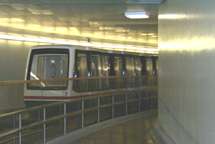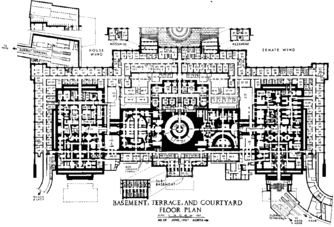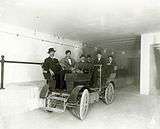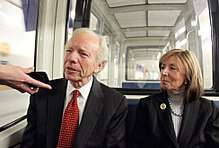United States Capitol subway system
The subway system of the United States Capitol in Washington, D.C., consists of three underground electric people mover systems that connect the United States Capitol to all three of the Senate office buildings and one of the four House office buildings.
 | |||||||||||||||||||||||||||||||||||||||||||||||||||||||
| Overview | |||||||||||||||||||||||||||||||||||||||||||||||||||||||
|---|---|---|---|---|---|---|---|---|---|---|---|---|---|---|---|---|---|---|---|---|---|---|---|---|---|---|---|---|---|---|---|---|---|---|---|---|---|---|---|---|---|---|---|---|---|---|---|---|---|---|---|---|---|---|---|
| Owner | U.S. federal government | ||||||||||||||||||||||||||||||||||||||||||||||||||||||
| Locale | United States Capitol Complex, Washington, D.C. | ||||||||||||||||||||||||||||||||||||||||||||||||||||||
| Transit type | People mover | ||||||||||||||||||||||||||||||||||||||||||||||||||||||
| Number of lines | 3 | ||||||||||||||||||||||||||||||||||||||||||||||||||||||
| Number of stations | 6 | ||||||||||||||||||||||||||||||||||||||||||||||||||||||
| Operation | |||||||||||||||||||||||||||||||||||||||||||||||||||||||
| Began operation | March 7, 1909 | ||||||||||||||||||||||||||||||||||||||||||||||||||||||
| Operator(s) | Architect of the Capitol | ||||||||||||||||||||||||||||||||||||||||||||||||||||||
| Number of vehicles | 7 | ||||||||||||||||||||||||||||||||||||||||||||||||||||||
| |||||||||||||||||||||||||||||||||||||||||||||||||||||||
History
The original subway line was built in 1909 to link the Russell Senate Office Building to the Capitol.[1] In 1960, an operator-controlled monorail was installed for the Dirksen Senate Office Building.[2] A two-car subway line connecting the Rayburn House Office Building to the Capitol was built in 1965.[3][4] The Dirksen monorail, which had been extended to the Hart Senate Office Building in 1982, was replaced in 1993 by an automatic train.[1][2]
Network

On the House side, an older, manned two-track system, with a single open-topped car operating on each track, shuttles passengers between the Rayburn House Office Building and the Capitol. On the Senate side, two separate subway lines exist. The first is similar to the one on the House side, connecting the Russell Senate Office Building and the Capitol. The other is a computer-controlled monorail system with three enclosed trains of three cars each running on a 90-second schedule, connecting the Hart Senate Office Building, the Dirksen Senate Office Building, and the Capitol.[5] The train cars are unpowered; the train is propelled by a track-side linear motor. This line has two parallel tracks for most of its length, but at the Hart and Capitol stations the tracks converge into one, with a single side platform. This allows easy return travel on the opposite track. The Dirksen station features a side platform for Capitol-bound trains and an island platform for Hart-bound trains. All three of these stations feature platform screen doors. A small maintenance spur is located adjacent to the Hart station. The House and Senate subway systems do not terminate in the same location under the Capitol, but they are connected by a labyrinth of tunnels.
The remaining three House office buildings are not serviced by the subway system; two (Cannon and Longworth) use a shared underground footpath tunnel while the third (Ford) has no underground connection to the capitol. A fifth office building (O'Neill) was also unconnected and was demolished in 2002.
Security
Members of the public can travel on the trains – usually during a tour of the Capitol Complex – but must be escorted by a staff member with proper identification. During votes, the House subway is restricted to congressional members. The Russell subway is restricted to members and staff during Senate votes.
Since the terrorist attacks of September 11, 2001, restrictions have been placed on visitors using the Senate subway between the Hart and Dirksen buildings.
Collisions
A collision occurred on October 2, 2007, in the Rayburn to Capitol subway line after a car failed to slow down when it reached the end of the track line. The operator was injured and taken to a hospital for observation.[6]
Image gallery
 Studebaker Electric subway car in 1909
Studebaker Electric subway car in 1909.jpg) Installing a monorail in 1912
Installing a monorail in 1912.jpg) Monorail car in 1912
Monorail car in 1912.jpg) Monorail car in 1912
Monorail car in 1912_(cropped).jpg) Installation of a new subway car sometime between 1958 and 1961
Installation of a new subway car sometime between 1958 and 1961 Subway car traveling to the Russell Senate Office Building in 2003
Subway car traveling to the Russell Senate Office Building in 2003 Then-Senator Joe Lieberman rides the subway to the Capitol with his wife Hadassah in 2011
Then-Senator Joe Lieberman rides the subway to the Capitol with his wife Hadassah in 2011
See also
- People mover
- United States Capitol Complex
- Washington Metro
- Moscow Metro 2
References
- Kessler, Ronald (1998). Inside Congress: The Shocking Scandals, Corruption, and Abuse of Power Behind the Scenes on Capitol Hill. Simon & Schuster. pp. 13–14. ISBN 0-671-00386-0. Retrieved August 11, 2009.
- Alexovich, Ariel (May 31, 2006). "The not-so-seedy underworld of Capitol Hill". Roll Call. Retrieved August 11, 2009.
- "The Rayburn House Office Building". Architect of the Capitol. Retrieved August 11, 2009.
- "Capitol Clinker". Time. January 15, 1965. Retrieved August 11, 2009.
- Political drama follows lawmakers underground to Capitol Hill subway (Youtube). Washington Post. 15 August 2017. Retrieved 23 February 2019.
- Yehle, Emily (October 4, 2007). "Subway Accident Injures One". Roll Call. Retrieved August 11, 2009.
External links
| Wikimedia Commons has media related to United States Capitol Subway System. |
- Capitol Subway System (Architect of the Capitol website)
- The United States Capitol Subway System (BelowTheCapital.org)
- Information about the Capitol Subway System (U.S. Senator Jeff Bingaman's website [archived version])